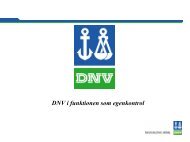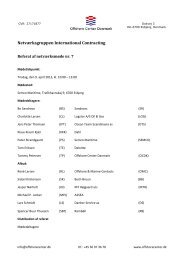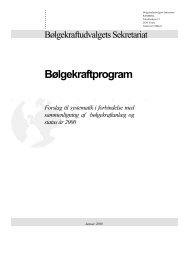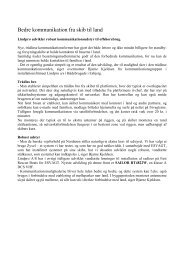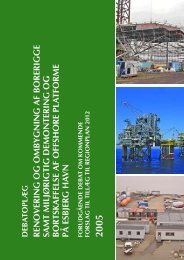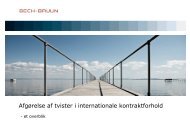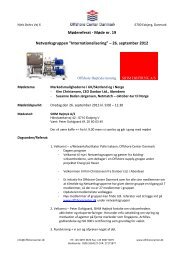Read News Magazine (pdf) - Offshore Center Danmark
Read News Magazine (pdf) - Offshore Center Danmark
Read News Magazine (pdf) - Offshore Center Danmark
Create successful ePaper yourself
Turn your PDF publications into a flip-book with our unique Google optimized e-Paper software.
CO2 from Power Stations<br />
to be used in Oilfi elds<br />
A research project started in<br />
2007 will determine whether<br />
CO2 can be used to increase<br />
the extraction degree in the<br />
Danish part of the North Sea.<br />
This could turn out to have a<br />
huge potential, the development<br />
manager from DONG<br />
Energy informs.<br />
<strong>Offshore</strong> <strong>Center</strong> <strong>Danmark</strong> has<br />
undertaken a preceeding pilot<br />
project in the period 2005-<br />
2007, to investigate increased<br />
oil recovery from the Danish<br />
chalk fi elds with participants<br />
from several companies as<br />
well as Aalborg University<br />
(Esbjerg Institute) and GEUS<br />
(Geological Survey of <strong>Danmark</strong><br />
and Greenland). CO2 injection<br />
and microbial addition was the<br />
main focus of the pilot project.<br />
12 <strong>Offshore</strong> <strong>Center</strong> <strong>Danmark</strong><br />
Yearbook 2008<br />
Can the residual product CO2 originating<br />
from the production of the Danish power<br />
stations be used to increase the extraction<br />
degree on oilfi elds in the North Sea and at<br />
the same time contribute to solve one of the<br />
planet’s greatest challenges within the environment:<br />
The discharge of CO2?<br />
A question raised by DONG Energy and<br />
several partners in a current research project<br />
supported by the Danish foundation for high<br />
technology. Denmark discharges more CO2<br />
per inhabitant compared to the European<br />
average – 11 tons compared to eight tons in<br />
the entire Europe – and of the 55 million CO2<br />
a year the power stations count for approximately<br />
50% of the discharge.<br />
– Several places CO2 is used in land-based<br />
drillings, especially in the US, and one of<br />
the questions is, whether we can transfer the<br />
knowledge from land in the US and Canada<br />
to the North Sea, where the distance between<br />
the wells is longer, the development manager<br />
Charles Nielsen, DONG Energy, informs.<br />
Neither in the Danish nor in the Norwegian<br />
part of the North Sea CO2 is as yet used to<br />
improve the degree of oil extraction, however<br />
MARGINAL<br />
FIELDS<br />
Statoil Hydro has during the approximately<br />
past 10 years deposited CO2 in connection<br />
with the extraction of natural gas. Before the<br />
injection of CO2 to increase the pressure in<br />
the wells could be taken into use, a series of<br />
tests are to be effectuated, where the infl uence<br />
of oil, installations and reservoirs is to<br />
be simulated.<br />
– I believe that on a long-term basis we will<br />
have a European infrastructure of pipelines<br />
to deposits on land, to drained oilfi elds and<br />
maybe to initiatives to improve the extraction<br />
on active oilfi elds. This could turn out to have<br />
a big potential; in my opinion, however, it<br />
will take another ten years to get it operating<br />
at 100%. The technology to isolate the CO2<br />
from the fl ue-gas is not yet in place, and on<br />
top of this the right facilities would also have<br />
to be constructed, Charles Nielsen explains.<br />
The objective of the EU countries is to reduce<br />
the CO2 discharge by 20% before 2010, and<br />
furthermore by 30%, provided that we reach<br />
a global agreement in 2009. One of the means<br />
to reach the objective could be investment of<br />
billions of DKK in order to transfer the CO2<br />
from the power stations to the oilfi elds. ■



